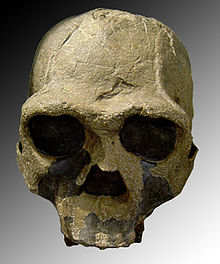
Back Homo ergaster Afrikaans إنسان عامل Arabic Homo ergaster AST Homo ergaster Azerbaijani Homo Ergaster BAR Homo ergaster Byelorussian Работещ човек Bulgarian হোমো এরগ্যাস্টার Bengali/Bangla Homo ergaster BS Homo ergaster Catalan
| Homo ergaster Temporal range: Early Pleistocene,
| |
|---|---|

| |
| KNM-ER 3733, a 1.6 million year old skull of Homo ergaster discovered in 1975 at Koobi Fora, Kenya | |
| Scientific classification | |
| Domain: | Eukaryota |
| Kingdom: | Animalia |
| Phylum: | Chordata |
| Class: | Mammalia |
| Order: | Primates |
| Suborder: | Haplorhini |
| Infraorder: | Simiiformes |
| Family: | Hominidae |
| Subfamily: | Homininae |
| Tribe: | Hominini |
| Genus: | Homo |
| Species: | †H. ergaster
|
| Binomial name | |
| †Homo ergaster | |
| Synonyms | |
|
† Telanthropus capensis[1] | |
Homo ergaster is an extinct species or subspecies of archaic humans who lived in Africa in the Early Pleistocene. Whether H. ergaster constitutes a species of its own or should be subsumed into H. erectus is an ongoing and unresolved dispute within palaeoanthropology. Proponents of synonymisation typically designate H. ergaster as "African Homo erectus"[2] or "Homo erectus ergaster".[3] The name Homo ergaster roughly translates to "working man", a reference to the more advanced tools used by the species in comparison to those of their ancestors. The fossil range of H. ergaster mainly covers the period of 1.7 to 1.4 million years ago, though a broader time range is possible.[4] Though fossils are known from across East and Southern Africa, most H. ergaster fossils have been found along the shores of Lake Turkana in Kenya. There are later African fossils, some younger than 1 million years ago, that indicate long-term anatomical continuity, though it is unclear if they can be formally regarded as H. ergaster specimens. As a chronospecies, H. ergaster may have persisted to as late as 600,000 years ago, when new lineages of Homo arose in Africa.
Those who believe H. ergaster should be subsumed into H. erectus consider there to be too little difference between the two to separate them into distinct species. Proponents of keeping the two species as distinct cite morphological differences between the African fossils and H. erectus fossils from Asia, as well as early Homo evolution being more complex than what is implied by subsuming species such as H. ergaster into H. erectus. Additionally, morphological differences between the specimens commonly seen as constituting H. ergaster might suggest that H. ergaster itself does not represent a cohesive species. Regardless of their most correct classification, H. ergaster exhibit primitive versions of traits later expressed in H. erectus and are thus likely the direct ancestors of later H. erectus populations in Asia. Additionally, H. ergaster is likely ancestral to later hominins in Europe and Africa, such as modern humans and Neanderthals.
Several features distinguish H. ergaster from australopithecines as well as earlier and more basal species of Homo, such as H. habilis. Among these features are their larger body mass, relatively long legs, obligate bipedalism, relatively small jaws and teeth (indicating a major change in diet) as well as body proportions and inferred lifestyles more similar to modern humans than to earlier and contemporary hominins. With these features in mind, some researchers view H. ergaster as being the earliest true representative of the genus Homo.
H. ergaster lived on the savannah in Africa, a unique environment with challenges that would have resulted in the need for many new and distinct behaviours. Earlier Homo probably used counter-attack tactics, like modern primates, to keep predators away. By the time of H. ergaster, this behaviour had probably resulted in the development of true hunter-gatherer behaviour, a first among primates. H. ergaster was an apex predator.[5] Further behaviours that might first have arisen in H. ergaster include male-female divisions of foraging and true monogamous pair bonds. H. ergaster also marks the appearance of more advanced tools of the Acheulean industry, including the earliest known hand axes. Though undisputed evidence is missing, H. ergaster might also have been the earliest hominin to master control of fire.
- ^ Broom, R.; Talbot, J. T. (1949). "A New Type of Fossil Man". Nature. 164 (4164): 322–323. Bibcode:1949Natur.164..322B. doi:10.1038/164322a0. PMID 18137042. S2CID 4106457.
- ^ Tattersall 2013, p. 5.
- ^ Tattersall 2013, p. 14.
- ^ Wood, Bernard; Doherty, Dandy; Boyle, Eve (29 May 2020). "Hominin Taxic Diversity". Oxford Research Encyclopedia of Anthropology. doi:10.1093/acrefore/9780190854584.013.194. ISBN 9780190854584. Retrieved 19 April 2021.
- ^ Ben-Dor, Miki; Sirtoli, Raphael; Barkai, Ran (2021). "The evolution of the human trophic level during the Pleistocene". American Journal of Physical Anthropology. 175: 27–56. doi:10.1002/ajpa.24247. PMID 33675083.
© MMXXIII Rich X Search. We shall prevail. All rights reserved. Rich X Search